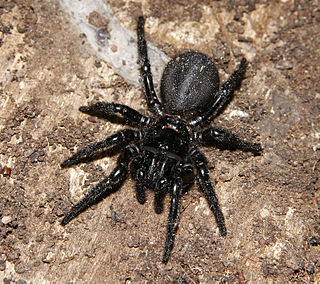
Atracidae is a family of mygalomorph spiders, commonly known as Australian funnel-web spiders or atracids. It has been included as a subfamily of the Hexathelidae, but is now recognised as a separate family. All members of the family are native to Australia. Atracidae consists of three genera: Atrax, Hadronyche, and Illawarra, comprising 35 species. Some members of the family produce venom that is dangerous to humans, and bites by spiders of six of the species have caused severe injuries to victims. The bites of the Sydney funnel-web spider and northern tree-dwelling funnel-web spider are potentially deadly, but no fatalities have occurred since the introduction of modern first-aid techniques and antivenom.

Hadronyche formidabilis, the northern tree-dwelling funnel-web spider, is a medically significant mygalomorph spider found in Queensland and New South Wales. It is also known as the Northern Rivers funnel-web spider or northern funnel-web spider.

Hadronyche is a genus of venomous Australian funnel-web spiders that was first described by L. Koch in 1873. Originally placed with the curtain web spiders, it was moved to the Hexathelidae in 1980, then to the Atracidae in 2018.

Hadronyche infensa, the Darling Downs funnel-web spider, is a venomous mygalomorph spider, one of a number of Australian funnel-web spiders found in Queensland and New South Wales.

Hadronyche cerberea, the southern tree-dwelling funnel-web spider, is a venomous mygalomorph spider found in central New South Wales, Australia.

Hadronyche versuta, the Blue Mountains funnel-web spider, is a venomous mygalomorph spider found in central New South Wales.

Hadronyche modesta, the Victorian funnel-web spider, is a species of spider found in Victoria, Australia.
Hadronyche macquariensis, the Port Macquarie funnel-web spider, is a venomous mygalomorph spider, one of a number of species of Australian funnel-web spiders] found in New South Wales.
Hadronyche annachristiae is a species of funnel-web spider in the Atracidae family. It is endemic to Australia. It was described in 2010 by Australian arachnologist Michael R. Gray. The species epithet annachristiae honours the author’s daughter, Anna-Christie Gray.
Hadronyche flindersi, also known as the Flinders Ranges funnel-web spider, is a species of funnel-web spider in the Atracidae family. It is endemic to Australia. It was described in 1984 by Australian arachnologist Michael R. Gray.
Hadronyche alpina, also known as the Alpine funnel-web spider or Kosciusko funnel-web spider, is a species of funnel-web spider in the Atracidae family. It is endemic to Australia. It was described in 2010 by Australian arachnologist Michael R. Gray. The specific epithet alpina refers to the alpine habitats in the Snowy Mountains region where the spiders are found.
Hadronyche emmalizae is a species of funnel-web spider in the Atracidae family. It is endemic to Australia. It was described in 2010 by Australian arachnologist Michael R. Gray. The species epithet honours the author's daughter, Emma Elizabeth Jensen Gray.
Hadronyche monaro is a species of funnel-web spider in the Atracidae family. It is endemic to Australia. It was described in 2010 by Australian arachnologist Michael R. Gray. The species epithet monaro refers to the Monaro region of south-eastern New South Wales.
Hadronyche orana is a species of funnel-web spider in the Atracidae family. It is endemic to Australia. It was described in 2010 by Australian arachnologist Michael R. Gray. The species epithet orana refers to the Orana region of central northern New South Wales.
Hadronyche nimoola is a species of funnel-web spider in the Atracidae family. It is endemic to Australia. It was described in 2010 by Australian arachnologist Michael R. Gray. The species epithet nimoola is an Aboriginal term meaning ‘steep slope’, with reference to the spider's head profile.
Hadronyche lamingtonensis, also known as the Lamington funnel-web spider, is a species of funnel-web spider in the Atracidae family. It is endemic to Australia. It was described in 2010 by Australian arachnologist Michael R. Gray. The species epithet lamingtonensis refers to the Lamington National Park, the type locality.
Hadronyche monteithi is a species of funnel-web spider in the Atracidae family. It is endemic to Australia. It was described in 2010 by Australian arachnologist Michael R. Gray. The species epithet monteithi honours Dr Geoff Monteith, collector of type specimens and other spider species.
Hadronyche raveni is a species of funnel-web spider in the Atracidae family. It is endemic to Australia. It was described in 2010 by Australian arachnologist Michael R. Gray. The species epithet raveni honours Dr Robert Raven, Senior Curator of Arachnology at the Queensland Museum.
Hadronyche meridiana, also known as the Central Victorian funnel-web spider, is a species of funnel-web spider in the Atracidae family. It is endemic to Australia. It was described in 1902 by British arachnologist Henry Roughton Hogg.
Hadronyche pulvinator, also known as the Cascade funnel-web spider, is a species of funnel-web spider in the Atracidae family. It is endemic to Australia. It was described in 1927 by Australian arachnologist Vernon Victor Hickman.





